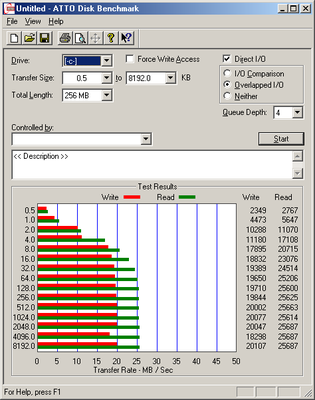DNSDies -
Your speed will likely be limited by the speed of the controller card.
Yes, I'm aware of this. But I still hope for speed-up over the dreaded old slow HDD... The intended board, Asus TXP4-X, does support PIO4 and DMA2. Both these are 16.7MB/sec rated. The card even support UDMA, witch could (at PIO4/DMA2) get me to 33.3MB/sec, but that is probably wishfull thinking.
CF cards are also quite slow when writing/reading small files under 512KB. Like, we're talking under 100 KB/s.
Are not there some caches that help? Still, that should be faster that the old HDD...
You might instead look into getting a cheap PATA Disk on Module SSD off ebay.
Will it be fater? Because CF card use the PATA interface, so there is no translation between PATA and SATA = fastest possible speed?
I got a 16GB DoM for my 486 120mhz using a VLB controller on PIO Mode 4, it's quite speedy.
What is DoM and no... my mainboard does not have VLBus. I have 4 PCI buses, tough. Can they be used for something meaningfull?
Marquzz -
I recently bought a CF-card to use with an CF-adapter I had, but didn't get it to work. I later read that new CF-cards can be difficult to get to boot from.
This is exactly what I fear. I was told that in such cases, the CF card must be changed from removable to fixed device.
Which DoM did you buy? I see this Kingspec-brand pop up and wondering if you can use two next to each other, one in each IDE-port, or if they are too thick. I'm looking at having a few with different OS-installation media on them so that I could skip my CD-ROM.
Makes me wonder, what these DoMs are... 😀
Sandisk response:
Dear Pavel,
I understand that you want to change your CF card from removable to fixed device.
Please allow us to inform you that CompactFlash cards can be configured to use “Fixed Disk mode” as this is defined by the CompactFlash specification.
SanDisk does not support its implementation with our consumer or professional-level cards as it is outside of the scope of their intended use. Thus, all of our consumer and professional cards are shipped, by default, in Removable mode.
SanDisk no longer offers an OEM or fixed disk Compact flash card line. There also is no utility available to change retail Compact Flash cards from removable to fixed disk.
Additional information you may read on the following web article:
Can I enable the Fixed Disk mode on my CompactFlash card?
In order to answer your question to which voltage the PATA to CF card adapter should be set, I will reply to you later as I will escalate this issue to our technical department, in order to give you a correct answer.
Thank you for your preference of our SanDisk products.
Click here to register your product online.
Please provide us your phone number (for technical support call back only)
Thank you for your kind cooperation.
Best regards,
Joanna R.
SanDisk Global Customer Care
...
So to put it short, I pay premium price for "CF card" that is not really a CF card, because I cannot change the bit that is defined by CF specification...? You are gotta be kidding me...
It is dangerous to be right in matters on which the established authorities are wrong. Voltaire
I believe that all the people who stand to profit by a war and who help provoke it should be shot on the first day it starts... Hemingway





